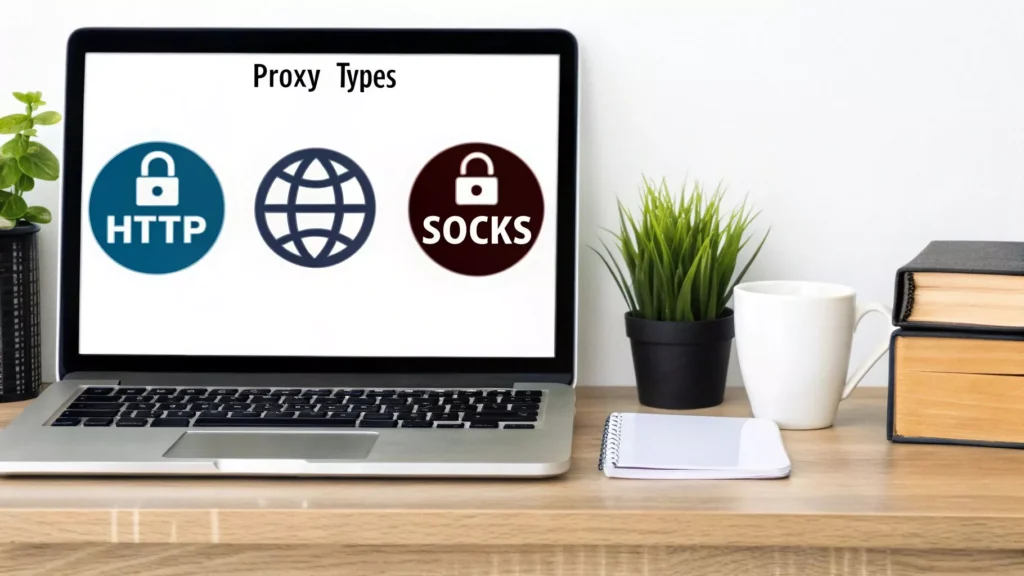A proxy server is essentially an intermediary that sits between you and the internet, handling all your web requests for you. Think of it as a digital go-between. Instead of your device connecting directly to a website, the proxy steps in and uses its own IP address, effectively hiding your online identity and location. This simple swap is a cornerstone of modern online privacy.
Your Digital Bodyguard on the Internet
Imagine you want to send a sensitive letter but don’t want the recipient to know your home address. You could give it to a trusted friend to mail for you. Your friend would put it in a new envelope with their return address, send it off, and pass any replies back to you. The person on the other end would never know it came from you.
That’s a perfect analogy for what a proxy server is in the digital world. It acts as your internet stand-in, creating a valuable buffer between your personal device and the vast, often unpredictable, web.

How This Process Works for You
When you browse through a proxy, your online activity takes a slightly different, but much safer, route. It’s a simple detour that shields your personal information.
- You Send a Request: First, you type a website address into your browser, like
www.google.com. That request doesn’t go straight to Google; it goes to the proxy server instead. - The Proxy Takes Over: The proxy server grabs your request and forwards it to Google using its own IP address. At this point, your personal IP is completely out of the picture.
- The Website Responds: Seeing the request from the proxy, Google’s servers send the search results page back to it.
- You Get the Information: Finally, the proxy server relays that information back to you. The whole exchange happens privately, without ever exposing your digital “home address.”
This intermediary role is more critical now than ever. The global proxy server market was valued at a whopping USD 3.4 billion in 2023 and is on track to hit around USD 7.2 billion by 2031, all thanks to the growing need for better cybersecurity. If you want to dive deeper, you can explore the full research on the proxy server market for more details.
To put it simply, here’s a quick breakdown of what a proxy does and why it matters.
| Proxy Server at a Glance | |
|---|---|
| Core Function | Primary Benefit |
| Acts as an intermediary between your device and the internet. | Hides your real IP address. |
| Forwards web requests using its own IP address. | Enhances your online privacy and security. |
| Receives website data and sends it back to you. | Allows you to bypass geo-restrictions and censorship. |
In short, a proxy gives you a powerful layer of control over your digital footprint.
A proxy server is your first line of defense in managing your digital footprint. It ensures that your personal IP address—your unique identifier online—remains private, giving you control over who sees your location and activity.
How a Proxy Server Actually Works

So, how does this all work behind the scenes? Let’s trace your internet request as it travels through a proxy.
Think of it like hiring a personal assistant to run an errand for you. Instead of driving to the store yourself, you give your assistant a list. They go to the store, make the purchase on your behalf, and bring it back to you. The store only ever sees and interacts with your assistant—they have no idea who you are.
A proxy server works in a surprisingly similar way. When you type a website into your browser, that request doesn’t fly directly to its destination. First, it’s rerouted to the proxy server you’re connected to. This is where the magic happens.
The Request Forwarding Process
Once your request hits the proxy, the server immediately steps in to act as your digital stand-in. It takes your request, carefully removes your personal IP address, and slaps its own IP address on instead. This core function, known as IP masking, is what makes a proxy so powerful for privacy.
Actionable Insight: For example, if you are in New York (IP address 71.200.50.100) and connect to a proxy in London (IP address 85.10.200.5), the website you visit will see your request as coming from London, not New York.
The proxy then forwards this repackaged request over to the website you want to visit. As far as that website is concerned, the traffic is coming directly from the proxy server, not your home or office. It has zero visibility into who originally sent the request, keeping your real location and identity under wraps.
It’s a simple but effective hand-off: the proxy intercepts your request, changes the return address to its own, and sends it on its way. The destination server never gets a glimpse of your real IP.
Completing the Connection Securely
After the website’s server processes the request, it sends back the response—the webpage content you were looking for. But it doesn’t send it back to you. It sends it to the only address it knows: the proxy server’s IP.
Finally, the proxy server receives that response from the website and forwards it straight to your device, completing the loop. The whole round-trip happens in milliseconds, and the website never makes direct contact with your computer. You get the content you wanted, and your digital footprint stays hidden.
We can break this whole sequence down into four quick stages:
- Your Request: Your device sends a request (e.g., to open
ipfly.net) to the proxy server. - IP Masking: The proxy replaces your IP with its own and forwards the request to the
ipfly.netserver. - Website Response: The
ipfly.netserver sends the webpage content back to the proxy server’s IP. - Final Delivery: The proxy relays that content back to your device, completing your request privately.
Choosing the Right Tool for the Job

Not all proxies are created equal, and picking the right one is like selecting the perfect tool from a workshop. You wouldn’t use a sledgehammer for a delicate job, and the same logic applies here. The best choice depends entirely on what you’re trying to accomplish—whether it’s raw speed, rock-solid anonymity, or appearing as a genuine user.
To make an informed decision, you first need to understand the fundamental types. The two most common categories are defined by where they come from: Datacenter and Residential proxies. Each serves a very different purpose and brings its own unique advantages to the table.
Datacenter vs. Residential Proxies
Datacenter proxies are the workhorses of the proxy world. These IPs aren’t tied to a home internet connection but originate from servers in massive data centers. Their biggest selling point is sheer speed and affordability, making them perfect for tasks that require rapid, high-volume requests.
Practical Example: A marketing company might use a pool of 10,000 datacenter proxies to quickly scan hundreds of websites for brand mentions. The high speed allows them to complete the task in minutes instead of hours.
Residential proxies, on the other hand, are IP addresses assigned by Internet Service Providers (ISPs) to real homes. Because their traffic looks like it’s coming from a genuine residential device, they are far less likely to be blocked or flagged by websites. This makes them the go-to choice for sensitive operations where blending in is absolutely critical.
Practical Example: A shoe reseller uses a residential proxy to check stock levels on a retailer’s website. The request appears as a normal customer, avoiding the anti-bot systems that would instantly block a datacenter IP. To get a better handle on this powerful option, check out our guide on how residential proxies from IPFLY work.
The key difference is trust. Datacenter IPs are fast but easily identifiable as non-human. Residential IPs are highly trusted because they look exactly like traffic from a real person browsing from home.
To help you decide, here’s a quick breakdown of the most common proxy server types and what they’re best suited for.
Comparison of Common Proxy Server Types
This table compares the key features, use cases, and anonymity levels of different proxy types to help you choose the right one for your specific needs.
| Proxy Type | Primary Use Case | Speed | Anonymity Level |
|---|---|---|---|
| Transparent Proxy | Content filtering (schools/offices) | High | None |
| Anonymous Proxy | Basic privacy, bypassing geo-blocks | Moderate | Medium |
| High Anonymity (Elite) Proxy | Secure browsing, sensitive tasks | Moderate to High | High |
| Datacenter Proxy | High-volume tasks, server testing | Very High | Medium to High |
| Residential Proxy | Web scraping, ad verification | Moderate | Very High |
| Rotating Proxy | Large-scale data collection | Varies | High |
Ultimately, the right proxy is the one that best matches your project’s demands for speed, trust, and privacy.
Understanding Anonymity Levels
Beyond where they come from, proxies are also classified by the level of privacy they offer. This is where you can fine-tune your tool to match your security needs, moving from simple redirection to complete concealment. There are three main tiers to know.
- Transparent Proxies: These proxies don’t hide your IP address at all. They pass it along to the destination server, which is why they’re often used by schools or companies for content filtering, not for privacy. For instance, a school might use one to block access to social media sites.
- Anonymous Proxies: This type of proxy hides your real IP address but still identifies itself as a proxy server. This stops websites from knowing your location but lets them know you’re using an intermediary. This is useful for general browsing where you want to avoid targeted ads based on your location.
- High Anonymity (Elite) Proxies: This is the top tier of privacy. An elite proxy conceals your IP address and does not identify itself as a proxy. To any website you visit, your traffic appears to come directly from the proxy’s IP as if it were the original source. This is the best choice for tasks like competitor analysis where you cannot risk being detected.
Putting Proxies to Work in the Real World

Knowing the mechanics behind a proxy server is one thing, but seeing how it solves real problems is where it all clicks. Proxies aren’t just for tech gurus; they’re used every day by individuals and businesses to get around common online headaches, turning theory into practical solutions.
Think about personal use. Imagine you’re traveling and want to catch up on your favorite show from back home. You fire up the streaming app, only to get that dreaded “not available in your region” message. It’s frustrating.
By connecting through a proxy server in your home country, you instantly swap your IP address. To the streaming service, you look like you’re right back on your couch, granting you full access. It’s that simple. The same idea helps shield your data when you’re on sketchy public Wi-Fi at a coffee shop or airport.
How Businesses Unlock Growth With Proxies
For businesses, proxies are less about convenience and more about gaining a serious competitive edge. They are absolutely essential for gathering accurate, unbiased data without getting blocked or fed misleading information by competitors.
Here’s a look at how companies put proxies to work every day:
- Competitor Price Monitoring: An e-commerce brand needs to keep its pricing sharp. Using rotating residential proxies, they can scrape competitor websites to pull pricing data. Each request looks like it’s coming from a different real shopper, so they can collect info without tripping any alarms.
- Ad Verification: A marketing agency has to make sure a client’s ads are showing up correctly in different countries. They use geo-targeted proxies to see the ads just like a local user in London, Tokyo, or Sydney would, ensuring everything is compliant and performing as it should.
- Market Research: A startup planning a product launch uses proxies to analyze social media trends and customer chatter across different regions. This stops their corporate IP from getting flagged for heavy activity, so they can gather genuine public feedback.
These data-gathering jobs are the bedrock of modern business strategy. If you’re curious about the technical side of things, you can learn more about how to implement effective data scraping with proxies from IPFLY.
A proxy server acts as a universal key for businesses. It unlocks access to global market data, verifies digital assets, and protects automated systems from detection, turning raw information into actionable insights.
Understanding the Benefits and Risks
Using a proxy server opens up a world of advantages, but it’s not without its pitfalls. On one hand, you get a powerful privacy boost by masking your IP, better security against sketchy websites, and the freedom to browse a more open internet. These perks are exactly why the proxy market is booming.
But not all proxies are created equal. Some are downright dangerous, especially the ones that lure you in with the promise of being “free.” That free price tag often comes with a hidden cost you don’t want to pay.
A trustworthy proxy is like a digital shield, but a bad one can punch a hole right through your security. The biggest risks almost always come from free services that have zero incentive to protect your data and every reason to sell it.
The Dangers of Unreliable Proxies
When you connect to a low-quality or free proxy, you’re handing your trust over to a complete stranger. This can backfire in some pretty serious ways.
- Data Logging and Selling: How do free proxies make money? Simple. Many of them log your browsing history—every site you visit, every form you fill out—and sell that data to advertisers or anyone else willing to buy it.
- Slow Performance and Downtime: Free services are notoriously slow and unstable. Their servers are usually overloaded, leading to constant buffering and disconnects that make them useless for any real task.
- Malware Injection: This is the scariest one. Some malicious proxy providers will actively inject ads or even malware directly into your web traffic, putting your device at immediate risk.
Making a Safe and Informed Choice
The key to avoiding these traps is to stick with a reputable provider that has a clear privacy policy and a solid network. You want a service that’s upfront about how it handles your data and delivers reliable performance, like the solutions you’ll find with IPFLY’s datacenter proxies. A quality provider puts your security first, always.
Actionable Insight: Before buying, always check reviews on trusted third-party sites like Trustpilot or G2. Look for recent feedback on speed, reliability, and customer support. A provider with consistently positive, detailed reviews is a much safer bet.
The demand for secure proxies is growing as more people wake up to the importance of privacy and cybersecurity. Right now, North America is leading the global proxy server market, mostly because of early adoption of security tech and major investments in infrastructure. You can discover more insights about the proxy market on DataIntelo.
By investing in a trustworthy service, you get all the benefits of using a proxy without gambling with your data.
How to Choose a Proxy Service You Can Trust
With so many proxy providers out there, picking the right one can feel like a shot in the dark. But it doesn’t have to be. To find a service you can actually trust, you need to look past the flashy marketing and focus on the technical details that genuinely impact performance and security.
First things first: check out the provider’s IP pool size and quality. A huge, diverse pool of IPs is your best defense against getting flagged or blocked. For example, a service with millions of rotating residential IPs is going to be far more effective for data scraping than a small, static block of datacenter IPs that everyone else is using.
Next, you have to think about performance. Look for providers that guarantee high uptime—ideally 99.9% or better—and deliver fast connections. A slow proxy isn’t just annoying; it can completely sink time-sensitive jobs, like scraping e-commerce sites for live pricing data.
Key Factors for Your Checklist
Beyond raw speed and IP variety, your checklist needs to cover security and support. These two things are non-negotiable and are often what separates a professional service from a risky, fly-by-night operation.
A trustworthy provider will always have a transparent, easy-to-understand privacy policy. You should know exactly how your data is being handled.
Never even consider a service that doesn’t scream from the rooftops that it has a “no-log” policy. Your online activity is your business, and any reputable provider will make that a core promise.
Finally, think about what happens when things go wrong. Because eventually, they will. When an issue pops up, you need fast, competent help. Look for providers offering 24/7 technical support through channels like live chat or email. Solid customer support is a huge sign that a company actually cares about its customers’ success.
Use these benchmarks to cut through the noise and evaluate your options:
- Large and Diverse IP Pool: This is crucial for high success rates and avoiding bans.
- High Uptime Guarantee: Don’t settle for anything less than 99.9% uptime.
- Transparent Privacy Policy: A clear “no-log” policy is a must-have for protecting your data.
- Responsive 24/7 Support: This is your lifeline for troubleshooting and resolving issues quickly.
Got Questions About Proxies? We’ve Got Answers
When you’re first diving into the world of proxies, it’s normal to have a few questions. Getting clear, straightforward answers is the best way to build a solid understanding, so let’s tackle some of the most common ones.
Are Proxy Servers Actually Legal to Use?
Yes, absolutely. Using proxy servers for legitimate reasons is 100% legal. Businesses and individuals use them every single day for things like protecting online privacy, accessing content that’s blocked in their region, or managing corporate networks securely. The technology itself is completely neutral.
Where it gets tricky, of course, is how you use it. If a proxy is used to carry out illegal activities, those actions are still illegal—the proxy doesn’t change that. For instance, using a proxy for market research is legal; using it to hack into a competitor’s server is not.
What’s the Real Difference Between a Proxy and a VPN?
This is a big one. While both proxies and VPNs boost your online privacy, they operate in fundamentally different ways. A proxy server usually handles traffic for a specific app, like your web browser. Its main job is to act as a middleman and mask your IP address.
A VPN (Virtual Private Network), on the other hand, is a much heavier-duty security tool. It works at the device level, creating an encrypted “tunnel” that secures all of your internet traffic, not just from a single application. This makes a VPN the stronger choice if you need comprehensive security across your entire device.
Think of it this way: a proxy is great for basic IP masking in one app. A VPN is what you want for encrypting every bit of data leaving your phone or computer.
Should I Bother with a Free Proxy Server?
Honestly? It’s a bad idea. We strongly recommend steering clear of free proxy servers. They might seem tempting, but they often come with serious risks that completely defeat the purpose of using a proxy in the first place.
You’re often looking at painfully slow speeds, constant disconnects, and major privacy threats. Many free providers log your browsing data and sell it to the highest bidder or inject their own intrusive ads into your web pages. For any serious or sensitive task, investing in a reputable paid provider isn’t just a better option—it’s the only safe one.


